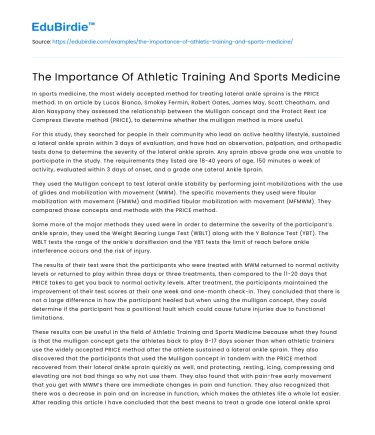In sports medicine, the most widely accepted method for treating lateral ankle sprains is the PRICE method. In an article by Lucas Bianco, Smokey Fermin, Robert Oates, James May, Scott Cheatham, and Alan Nasypany they assessed the relationship between the Mulligan concept and the Protect Rest Ice Compress Elevate method (PRICE), to determine whether the mulligan method is more useful.
For this study, they searched for people in their community who lead an active healthy lifestyle, sustained a lateral ankle sprain within 3 days of evaluation, and have had an observation, palpation, and orthopedic tests done to determine the severity of the lateral ankle sprain. Any sprain above grade one was unable to participate in the study. The requirements they listed are 18-40 years of age, 150 minutes a week of activity, evaluated within 3 days of onset, and a grade one Lateral Ankle Sprain.
Save your time!
We can take care of your essay
- Proper editing and formatting
- Free revision, title page, and bibliography
- Flexible prices and money-back guarantee
They used the Mulligan concept to test lateral ankle stability by performing joint mobilizations with the use of glides and mobilization with movement (MWM). The specific movements they used were fibular mobilization with movement (FMWM) and modified fibular mobilization with movement (MFMWM). They compared those concepts and methods with the PRICE method.
Some more of the major methods they used were in order to determine the severity of the participant’s ankle sprain, they used the Weight Bearing Lunge Test (WBLT) along with the Y Balance Test (YBT). The WBLT tests the range of the ankle’s dorsiflexion and the YBT tests the limit of reach before ankle interference occurs and the risk of injury.
The results of their test were that the participants who were treated with MWM returned to normal activity levels or returned to play within three days or three treatments, then compared to the 11-20 days that PRICE takes to get you back to normal activity levels. After treatment, the participants maintained the improvement of their test scores at their one week and one-month check-in. They concluded that there is not a large difference in how the participant healed but when using the mulligan concept, they could determine if the participant has a positional fault which could cause future injuries due to functional limitations.
These results can be useful in the field of Athletic Training and Sports Medicine because what they found is that the mulligan concept gets the athletes back to play 8-17 days sooner than when athletic trainers use the widely accepted PRICE method after the athlete sustained a lateral ankle sprain. They also discovered that the participants that used the Mulligan concept in tandem with the PRICE method recovered from their lateral ankle sprain quickly as well, and protecting, resting, icing, compressing and elevating are not bad things so why not use them. They also found that with pain-free early movement that you get with MWM’s there are immediate changes in pain and function. They also recognized that there was a decrease in pain and an increase in function, which makes the athletes life a whole lot easier. After reading this article I have concluded that the best means to treat a grade one lateral ankle sprain is to use the Mulligan Concept along with some elements of PRICE, with that said I think that athletic trainers should not rely as heavily on the PRICE method when there are other ways like the Mulligan Concept that could also help with the rehab of an injured athlete.






 Stuck on your essay?
Stuck on your essay?

